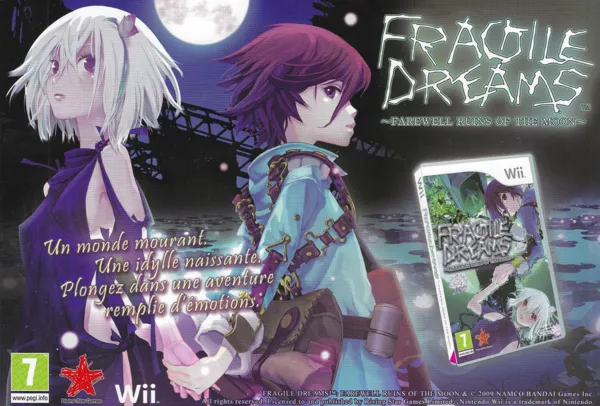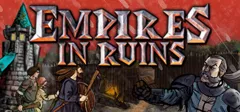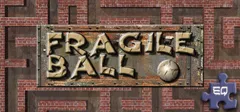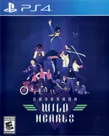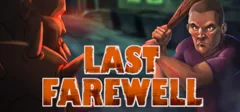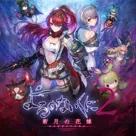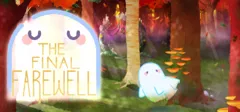Fragile Dreams: Farewell Ruins of the Moon
Description
Fragile Dreams takes place after an apocalyptic event that wiped out most of mankind. Young Seto finds a note from his deceased grandfather urging him to travel to the red tower that lights up the night sky. Along the way he finds a young, silver haired girl Ren who drives him to journey through the ruined world in search of companionship.
Fragile Dreams: Farewell Ruins of the Moon is an action-adventure game with light RPG elements and a focus on exploring the often desolate surroundings. Players are tasked with navigating the empty environments while fighting ghosts and obtaining items such as sketches and short stories that reveal the last moments of the lives of those lost in the great catastrophe. Seto is guided through a third-person perspective and the flashlight is one of his most important aids. Controlled through the Wii Remote it illuminates dark surroundings to interact with the environment and is needed to solve many puzzles. It can also uncover hidden enemies and often a sound through the mini speaker provides a hint about their location.
The Nunchuck is used to walk, sneak around, and crouch. It is possible to go into a first-person perspective to get a better view of the environment. Additional weapons that can be picked up during the course of the game are sticks, an iron pipe, a bow, a hammer, a bamboo sword, and a katana.
Spellings
- フラジール さよなら月の廃墟 - Japanese spelling
Groups +
Promos
Credits (Wii version)
228 People (178 developers, 50 thanks) · View all
| Seto | |
| Ren | |
| Sai | |
| PF | |
| Crow | |
| Chiyo | |
| Shin | |
| Merchant | |
| Tracker | |
| Old Man (Grandpa) | |
| Seto (Adult) | |
| Paper Crane Girl | |
| Mother | |
| Akane | |
| Mao | |
| Bell | |
| Mother | |
| Boy | |
| Boss | |
| Youth A | |
| Youth B | |
| Rika | |
| Mama | |
| Teacher | |
| [ full credits ] | |
Reviews
Critics
Average score: 68% (based on 46 ratings)
Players
Average score: 3.9 out of 5 (based on 9 ratings with 1 reviews)
A profoundly moving game, unlike any I've ever played.
The Good
Fragile Dreams was one of those games I didn't intend on buying until I ended up walking past it in the store. I had read the reviews, listened to the word of mouth and watched the footage. My mind was not totally made up.
There were reasons I considered buying the game; the Japanese dub, the immersive atmosphere and the impressive implementation of the IR pointer on the Wii remote as a flashlight. There were other games out there though, yet I inexplicably ended up settling on this. I'm glad I did as well, as I was constantly moved, almost to tears, by this beautiful game.
Fragile Dreams tells the story of a lonely 15 year old boy named Seto. After the old man who was taking care of him died he was left with nothing other than a strange crystal and a note telling Seto to head towards the red tower that punctuated the night sky outside of his observatory home. So Seto set off through the empty cities and deserted streets, scrambling through the crumbling relics of abandoned buses and cars, festooned with weeds like the empty buildings all around him. Soon Seto came across a young, silver haired girl who runs away and triggers in him a desire to be with someone, anyone. Seto's loneliness spurs his journey and fuels his resolve as he trudges through the mysterious world of ruin and abandon.
Seto's predicament is incredibly profound. I found myself so connected to him, relating to his situation in a very tangible manner. Seto is after all completely alone, yet he repeatedly reminds himself that he cannot be the only one who feels this way, convinced that others out there are searching just like him for companionship in an otherwise cold, lonely world. I find myself thinking this a lot, and a lot of the sadness I felt through the game was based on that empathy that Seto's predicament generated. In my personal situation, in a world of billions of people I am effectively alone. Those walking on the streets with me may as well be ghosts, simply flitting by completely indignant towards my existence. Yet I know eventually I will find someone just like me, who is simply seeking companionship, just like Seto. The scenario is pure genius, appealing to that sense of alienation everyone feels at one stage or another. It's this meditation on companionship and human emotion that causes Fragile's story to transcend what is otherwise a fairly standard mad scientist story.
Fragile's game play depends on fairly tried and true action/adventure dynamics with some light RPG elements to add that spice of achievement to the hacking and slashing. Seto moves forwards, backwards and strafes using the Nun-chuck. His view and flashlight are tied to the Wii remote, which realistically illuminates his surrounding environment wherever you so happen to point it. Pressing Z on the Nun-chuck causes the camera to lock itself behind Seto and the C button causes him to crouch, offering access to tight spaces. It's a very stress free control scheme and the pointer controlled view is really intuitive once you get the hang of it.
There are several classes of weapon; Light, Medium, Heavy and Ranged with each class offering a specific benefit over another. For instance a Medium weapon might be slower than a Light weapon but can be charged and swung around in a circle to hit multiple enemies at once, whereas a Light weapon can strike multiple times in the time it would take to hit once with a Medium weapon. Depending on the enemies you are encountering you can switch out your weapons accordingly, until they break that this.
Yes, weapons can break. This requires you to discard and replace them. It's not as tedious as it sounds and it takes quite a while for a weapon to break, normally it only happens after fighting a boss. Your inventory can be managed by heading to a bonfire, which also functions as a save point, in addition to healing you and letting you barter with a traveling merchant dressed as a chicken. He's a charming fellow and isn't totally one dimensional, his character is eventually elaborated on and although it's a little out of left field, his motives for doing what he does are heartbreaking. From the bonfire screen you can manage Seto's inventory, placing things you don't need in the suitcase which automatically sorts out all of your weapons, healing items, memory items and quest items saving you the pain of doing that yourself.
Personally, I think criticism regarding the bonfire save system is not only unfair but totally childish. The criticism in reviews I have read has targeted it as an archaic game play mechanic based on the item box system introduced in Resident Evil. While this comparison is somewhat accurate the implementation in Fragile is totally different. The game essentially plays linearly, with one or two instances of back tracking to obtain a quest item or find an alternate route to somewhere else. Bonfires are provided quite liberally and are very obviously placed. Those having trouble playing the game with this system are either very spoiled or are incredibly inept at playing video games. It's arrogant and pompous to totally discount it, as there is a strategy involved in how you use the bonfires. I won't go on about this anymore, I just wanted to add some balance to the criticism being leveled.
The environments Seto rambles through are haunting shells of better times. An amusement park sits rusting against a twilight sky, filled not with the delighted squeals of children but rabid dogs and spirits. A once well maintained field sits unkempt and overgrown, rides infiltrated and slowly being destroyed as nature reclaims her stolen spaces. At another point Seto finds himself in a crumbling hotel, a tree penetrating the walls and essentially becoming part of the building. Dirty curtains twist and dance in the breeze as bright sunlight casts shadows over the mossy concrete inside the ransacked rooms.
Every room and hallway has been constructed with this haunting loneliness, the signs of civilization nothing more than old relics slowly being turned to rubble by the encroaching weeds and tree life. It's all rendered in such a magnificently subtle way, from the discarded teddy bears to the gentle to and fro of the leaves on a tree through a window. There's always something for you to see, to remind you of how busy and alive these places used to be, it's genius artistic direction.
In regards to the tech, it's incredibly solid. Seto and the other characters in the game are rendered with immaculate detail, their lips synching perfectly to the dialogue. The vibrant colors of some scenes contrast with the dim twilight of others, with Seto's flashlight doing nothing to alleviate the sense of isolation and creeping dread that these areas exhibit. The texture work is beyond reproach, with everything plastered with distinctive, high resolution imagery. Though there isn't a lot of variety to them enemies are animated well, with distinctive form and character from the ghostly jellyfish to the moaning women with pins coming out of their backs.
An important thing for me to note is the soundtrack, or distinctive lack thereof. In scenes where music isn't necessary, it isn't there. All you get is the echoing stomp of Seto's footsteps and the wind as it courses eerily through tree branches and dank tunnels. When enemies come into range a maudlin piano begins to play accompanied by sad strings that follow you until you either dispatch your foes or run out of range. So yes, there is boss and regular encounter music. There is also the music that accompanies Seto's revelations and discoveries, the tender melodies that play when his heart is broken and the heart-wrenching piano dirge that accompanies your final encounters. Like every other stylistic element in this game the soundtrack is incredibly refined and accomplished.
The inclusion of both the English dub and Japanese original voice over track is very appreciated. I don't pretentiously ignore the English dub of anime and video games (when you rarely get the chance to choose between the two) it's just I've never heard a Japanese dub I haven't liked. English dubs tend to be decidedly terrible, with many things either lost in translation or characters exaggerated or played wrong. So for me personally it was very nice to be able to play the game in Japanese, I appreciated the effort. Just out of curiosity, I played through the game in English. It's not bad, the dub is about on par with many higher quality anime dubs. So, whatever language you play the game in you will get a competently acted story.
One final thing I'd like to mention about the audio are the Memory items which are picked up as the game progresses. These items function as short stories, superbly acted pieces of mini-fiction that give insight into the minds and feelings of people before the great catastrophe that befell mankind. There is no practical use for these, however they add a layer of depth to the entire experience that goes beyond anything I've seen in a game before. They add a dimension of humanity to the entire experience. You know everyone is gone, but in games along a similar vain we don't really care. In Fragile you understand the loss of life so much better than if this feature was left out of the game.
The Bad
There isn't much about Fragile I didn't enjoy. What I didn't enjoy were tiny things.
For instance, some enemies are designed to drift in and out of existence, this is understandable however it also means if you don't have your wits about you you will suffer a few cheap hits. In addition to that enemies can block corridors which was a little frustrating. It was difficult to sometimes see some enemies with a Ranged weapon equipped as you are denied the use of a flashlight when using one.
There is no checkpoint system in Fragile and if you are particularly daring and like to go without saving something disastrous could happen and you could end up going back an hour to your last save if you die. If you remember to save regularly it's not a problem, remember what I mentioned about the abundance of bonfires.
Some hallways are far too long, with little to do while you spend 5 minutes simply running in one direction to get to a door.
The Bottom Line
Fragile Dreams, in my opinion, is a masterpiece. It's a game that worked so intelligently on so many levels to evoke the most profound emotions in me. I felt so connected to Seto, I identified with his plight and I was genuinely moved, almost to tears, during the 10 hours it took me to finish the game.
The game play is rock solid, the engine is polished and the variety of environments and scenario's leaves the game feeling fresh up until the very end. There is a lot about the game I haven't even mentioned from the cat's you find on your journey to the occasional distractions here and there. I'll stop now and let you see for yourself how fantastic this game is.
Wii · by AkibaTechno (238) · 2010
Trivia
Development
The game's design and graphic direction were handled by the team at NAMCO BANDAI Games Inc. responsible for the PS2 RPGs Seven: Molmorth no Kiheitai (2000) and Venus & Braves: Majo to Megami to Horobi no Yogen (2003). The team is called Project FRAGILE in the credits.
Analytics
Upgrade to MobyPro to view research rankings!
Related Sites +
-
Fragile ~さよなら月の廃墟
official Japanese website -
Wikipedia: Fragile Dreams: Farewell Ruins of the Moon
article in the open encyclopedia
Identifiers +
Contribute
Are you familiar with this game? Help document and preserve this entry in video game history! If your contribution is approved, you will earn points and be credited as a contributor.
Contributors to this Entry
Game added by AkibaTechno.
Additional contributors: MAT, Sciere, Ben K, Patrick Bregger.
Game added July 30, 2010. Last modified March 23, 2024.

